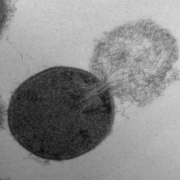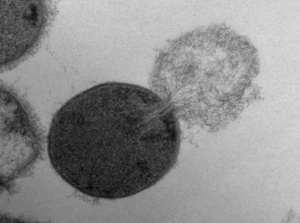Hidden genes could be key in development of new antibiotics
A study from the Centre for Phage Technology, part of Texas A&M’s College of Agriculture and Life Sciences and Texas A&M AgriLife Research, shows how the “hidden” genes in bacteriophages – types of viruses that infect and destroy bacteria – may be key to the development of a new class of antibiotics for human health.
The study has been published in Nature Communications and Current Science Daily, as well as featured in a recent Nature Research Microbiology Community blog post.
Antibiotic-resistant bacteria pose an increasing threat to human health, creating an urgent need for the development of novel antibiotics.
“There has been an increased interest in bacteriophages and their potential as antibacterial agents to fight pathogenic bacteria,” said Centre for Phage Technology director Ryland Young, Ph.D., who supervised the study research. “This is in large part due to the ability of the ‘lysis genes’ of the phage to cause a cellular breakdown in the bacterial host.”
The need for new and more effective antibiotics has increased interest in bacteriophages as possible agents to fight pathogenic bacteria.
Most phages can cause their host cell to rupture, a process called lysis. They also release new “progeny” phage virions that are genetically and structurally identical to the parent virus.
“Small phages, such as the ones this study focuses on, make a single protein which causes host lysis,” Young said. “Basically, the virus produces a ‘protein antibiotic’ that causes lysis in the same way antibiotics like penicillin do – by disrupting the multistage process of cell wall biosynthesis. When the infected cell tries to divide, it blows up because it can’t create the new cell wall between the daughter cells.”
He said these small lysis proteins can be the model for a completely new class of antibiotics.
The study focuses on characterizing the lysis genes of leviviruses, bacteriophages containing small single-stranded RNA genomes with only three to four genes. Tens of thousands of leviviruses have been discovered. Among the known levivirus genes is Sgl, which stands for ‘single gene lysis.’ Sgl encodes a protein that induces the cellular breakdown of bacteria.
“We wanted to discover these ‘hidden’ lysis genes in single-stranded RNA phages, as well as understand how their structure and evolution could benefit development of new, more effective antibiotics,” said Karthik Chamakura, Ph.D., a postdoctoral research associate at the centre and the study’s first author. “We also wanted to investigate how certain molecular targets within bacteria could be identified and exploited for antibiotic development.”
Reference:



